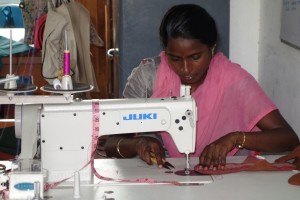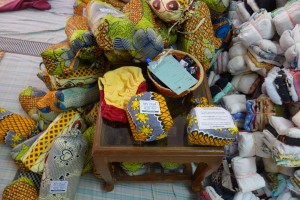This summer, I bought a new camera. I needed it to snap pictures during a research trip to India where I explored diverse approaches to what’s called in the development sector, Menstrual Hygiene Management (MHM). I chose a sleek, high tech device with a powerful, intuitive zoom.

Photo by author
In Bangalore, I captured the sweet intimacy of two schoolgirls as they watched the menstrual health animated video “Mythri” at a government school. In Tamil Nadu, I used my zoom for close shots of skilled women tailors sewing brightly colored cloth menstrual pads for the social business, Eco Femme.

Photo by author
In South Delhi, I used my zoom to preserve the mounds of cloth painstakingly repurposed as low cost menstrual pads at NGO Goonj.
But here’s the problem. These close up shots may please the eye, but they leave out the context that surrounds and shapes each photo’s subject. And what exists outside the frame is at least as important as what is inside. That’s hardly a revelation, I realize, but when it comes to doing Menstrual Hygiene Management work, in an effort to find solutions, the “big picture”—both literally and figuratively—sometimes gets obscured.

Photo by author
For example, when I snapped the picture of the mound of menstrual pads pictured here, I focused on a product, a simple product, that could truly improve the quality of someone’s life. But when I trained my attention on the product, what did I miss?
In short, a wider angle lens reveals the context of menstrual product access—a complicated web of many intersecting issues: infrastructural deficits (safe, secure, and clean latrines and sites for disposal), access to resources (like soap and water), gender norms, and menstrual restrictions rooted in culture or religion.
Imagine that one of brightly colored packages of menstrual pads ends up in the hands of a 15 year old girl. I will call her Madhavi.
Madhavi is delighted to have a dedicated set of her very own clean rags to absorb her flow.

Goonj worker with pads ready for distribution and sale
Photo by author
But does she have access to clean water and soap to wash them?
Does she have family support to dry her rags on the clothesline, in direct sunlight, even though her brothers, uncles, and neighbors will be able to see them?
Does she have a safe, secure place at school to change her rags?
Does she have someone to turn to when she has a question about her menstrual cycle?
These questions are important because they point to what gets in the way of effective and sustainable MHM. My own review of the emerging empirical literature on MHM revealed that the top three impediments to school girls’ positive and healthy menstrual experiences are 1) inadequate facilities 2) inadequate knowledge and 3) fear of disclosure, especially to boys. I want to focus on this last one for a moment by widening the frame a bit more.
Menstrual Hygiene Management is part of a complex and enduring project of loosening the social control of women’s bodies, of working to move embodiment, more generally, from object to subject status—something absolutely foundational to taking on a host of other urgent issues; from human trafficking to eating disorders to sexual assault.
As we know throughout the West, menstrual taboos do not disappear as we upgrade our menstrual care. Without the heavy lifting of menstrual normalization, any menstrual care practice will make a minimal impact.
Thus, menstrual activism must always incorporate an analysis of how gender norms maintain the menstrual status quo. And it must engage the potential of men and boys as allies, not enemies. That’s a tall order that cuts to the very core of gender socialization. But if we don’t take this on, no product in the world will be enough.
Anyone with a camera knows that framing a picture is a choice. Am I suggesting that we should never use the zoom, that we should forgo the rich and textured details possible when we tighten the shot? Of course not, as focus is crucial to our understanding. But when we do aim our figurative cameras and shoot, let’s not forget what lies outside the visual frame. Let’s not forget what else must change for the pad to be a truly sustainable solution.
With this in mind, I turn back to Madhavi and her new pads. Inevitably, even with them, one day soon, someone will know she is menstruating.
Will she be shamed? Will she be supported?
The answer lies in how we frame the picture.
This blog post appears on Girls Globe as part of a series of invited posts organized by Irise Interational.

